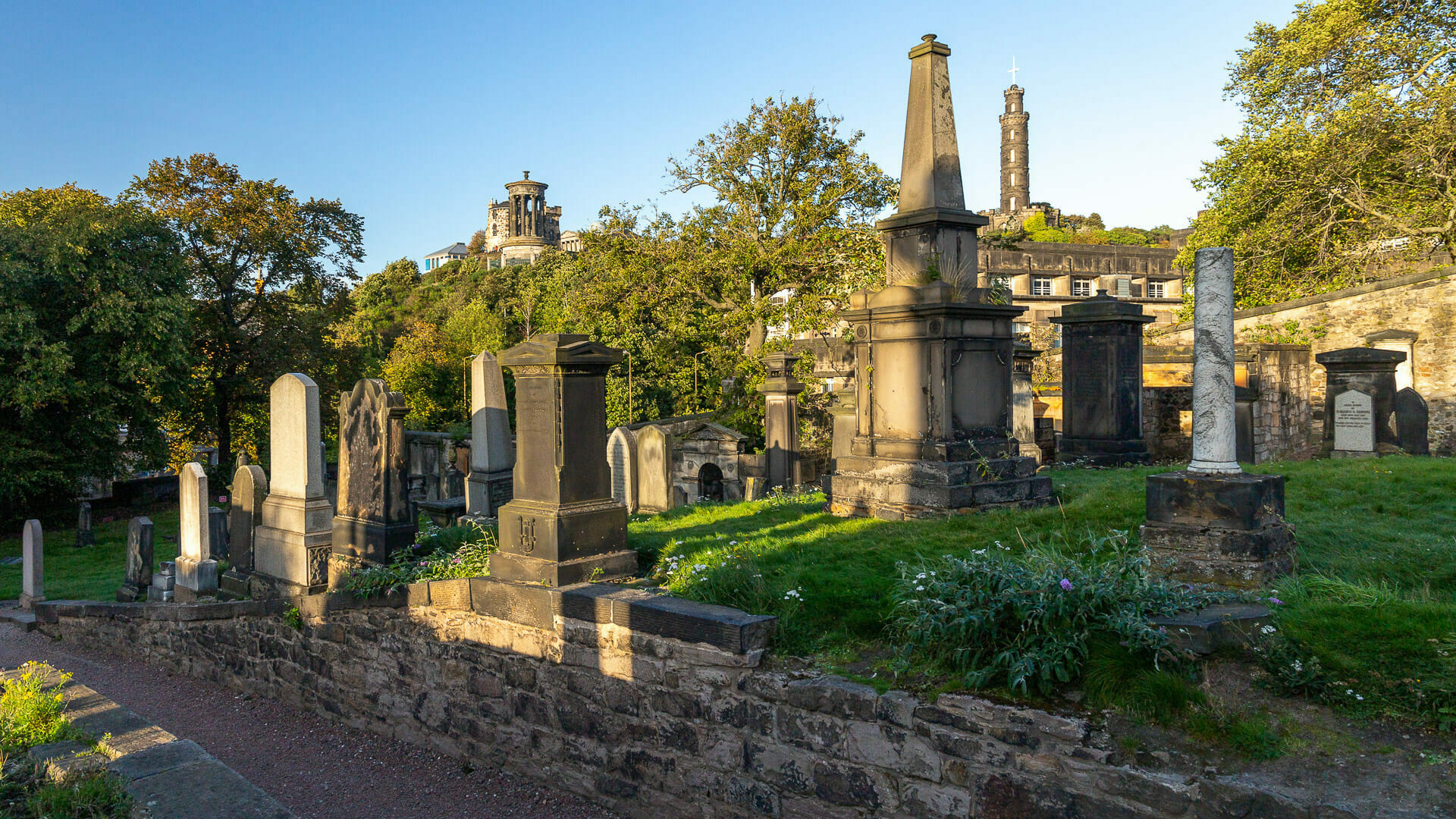The Old Calton Burial Ground is located in a prominent position in the centre of Edinburgh. Yet most tourists walk past it. What they miss.

Many hurry past the steps to the Old Calton Hill Burial Ground on their way to the Calton Hill viewpoint. Perhaps also because the cemetery is not so conspicuous on the street side.
A stone gate with a round arch and bars, behind it a staircase – that’s all you can see. The fact that there is a beautiful old cemetery at the end is only revealed to those who climb the steps.
The steps lead into a kind of hollow path that cuts through the hill. To the left and right are the old gravestones of the Old Calton Burial Ground.
At the end of the path to the south of the cemetery are larger monuments. There is even an obelisk towering high up here, as well as a circular mausoleum and … Abraham Lincoln!?!?
Yes, the president under whom the American Civil War was fought also poses here as a monument. Or rather: the monument shows him and a grateful, freed slave at his feet. But all this is not to commemorate him, but Scottish soldiers who lost their lives for the Union in the American Civil War.
The so-called Emancipation Monument was erected in 1893 and is supposedly the only memorial to the American Civil War outside the USA. And it is the first statue of Lincoln to be erected outside the USA.
In the background of Lincoln’s imposing stature, a cylindrical mausoleum rises on the Old Calton Burial Ground. A great name is emblazoned above the gate: David Hume. The mortal remains of the famous Scottish philosopher of the Enlightenment have lain here since 1776. Visitors will look in vain for Christian symbolism: Hume died an atheist.
And then there is the obelisk, the towering monument to the five political martyrs. One of them, for example, is Thomas Muir, who is regarded as the father of Scottish democracy. In the spirit of the French Revolution, Muir also campaigned for civil rights in Scotland. He was promptly deported to the penal colony in Australia in 1794 for his efforts. Although he managed to escape back to Paris, he died there in 1799.
The obelisk looks almost better from a distance, as it is part of the ensemble of the entire Calton Hill.
At the back of the Old Calton Burial Ground there are many small mausoleums along the wall of the cemetery.
The crenellated towers at the east end of this row are part of the Governor’s House, the last remnant of Calton Jail – Scotland’s largest prison, which stood here until 1937. It was demolished to make way for St Andrew’s House, which is now home to the Scottish Executive.
Many famous people from Edinburgh – architects, publicists, actors and merchants – still lie in the Old Calton Burial Ground. They are commemorated by large and small gravestones, mausoleums and obelisks. In the centre of the city, hidden from the view of most tourists.
Knowledge: About the Old Calton Burial Ground
The cemetery on Calton Hill dates back to 1718 and although the site was far away from the parish church in Leith, it was wonderfully close to the community who wanted to bury their dead.
When Edinburgh’s New Town was developed around 1800, this new neighbourhood for the wealthy also needed a nearby cemetery. In addition, the Greyfriars Kirkyard in the old city centre of Edinburgh was already overcrowded. As a result, many distinguished people found their final resting place in what is now the Old Calton Burial Ground.
However, the neighbourhood of the dead soon became dubious: With Calton Jail, the government built the largest prison in Scotland at the time on the east side of the cemetery. And it got even worse.
The reason why visitors today have to climb up to the graves via a flight of steps and a hollow path is due to the road that was built through here around 1815. It cut through the centre of the old cemetery and was much lower than the cemetery mound. Part of the Old Calton Burial Ground is cut off to the north of the road.
The city compensated for the missing Old Calton Burial Ground with the New Calton Burial Ground a little further east, where burials have been taking place since 1817. Incidentally, this cemetery is also well worth a visit.
From 1865, further burials at the Old Calton Burial Ground were prohibited. Nevertheless, there were further projects, such as the erection of the memorial to the Scottish soldiers who fought on the Union side in the American Civil War in 1893.
Tip: Tour of five cemeteries
Edinburgh has five historic cemeteries, all of which are worth a visit: the new and old Calton Burial Ground, Greyfriars Kirkyard, St Cuthbert and Canongate Kirkyard. They can all be explored in a walk of around 3.5 kilometres across the city (5 kilometres as a circular route). You should allow around an hour’s walking time. There are beautiful PDF leaflets about the tour, which also show the special features of each cemetery. All information can be found on the Edinburgh World Heritage page on the cemeteries.
Dean Cemetery is not included. It can be explored as part of the Dean Village walk .
How to get there:
On foot: The Old Calton Burial Ground is located on Waterloo Place, which forms the eastern extension of Princes Street and is easily reached on foot from there. The entrance is on the right-hand side coming from Princes Street.
With satnav: “EH8 8BG” will take you to the city centre.
Without satnav: If you are lucky and have a lot of money, you can park your car directly opposite the cemetery as an extension of Princes Street.